| dc.contributor.advisor | Jesús A. del Alamo. | en_US |
| dc.contributor.author | Villanueva, Anita A. (Anita Ariel), 1978- | en_US |
| dc.contributor.other | Massachusetts Institute of Technology. Dept. of Electrical Engineering and Computer Science. | en_US |
| dc.date.accessioned | 2008-02-27T22:47:27Z | |
| dc.date.available | 2008-02-27T22:47:27Z | |
| dc.date.copyright | 2007 | en_US |
| dc.date.issued | 2007 | en_US |
| dc.identifier.uri | http://hdl.handle.net/1721.1/40547 | |
| dc.description | Thesis (Ph. D.)--Massachusetts Institute of Technology, Dept. of Electrical Engineering and Computer Science, 2007. | en_US |
| dc.description | Vita. | en_US |
| dc.description | Includes bibliographical references (p. 155-161). | en_US |
| dc.description.abstract | GaAs Pseudomorphic High-Electron Mobility Transistors (PHEMTs) are widely used in RF power applications. Since these devices typically operate at high power levels and under high voltage biasing, their electrical reliability is of serious concern. Previous studies have identified several distinct degradation phenomena in these devices, but a complete picture has yet to be formed. In this study, we have carried out a comprehensive study of the mechanisms of electrical degradation on a set of experimental RF power GaAs PHEMTs (non-commercial devices provided by our sponsor, Mitsubishi Electric). A wide variety of electrical stressing experiments employing different conditions (varying temperature, bias, environment) were performed on these devices in order to monitor their degradation with stressing. Our general observations showed several forms of degradation, the most concerning being an increase in the drain resistance RD and a reduction in maximum drain current Imax. Contrary to what is often claimed in the literature, our experiments indicated that these forms of degradation were not driven by impact-ionization or hot-electron effects. Instead, we found the degradation to be strongly correlated with temperature, stressing environment, and drain-gate bias, which were all consistent with a corrosion mechanism. Via materials analysis we were able to confirm that the degradation of both RD and Imax were due to surface corrosion on the drain side of the device, albeit at different specific locations. The increase in RD was attributed to oxidation on the n+GaAs ledge, while the reduction in Imax was due to oxidation on the AlGaAs surface, closer to the gate. | en_US |
| dc.description.abstract | (cont.) A recoverable negative shift in the threshold voltage VT and a permanent decrease in Rs were also observed during electrical stressing. The shift in VT was attributed to field-assisted tunneling of electrons out of traps under the gate, while the decrease in Rs was found to be consistent with recombination-induced annealing of defects on the source side of the device. Measurements were also performed to observe light emitted from the device during electrical stressing. The observed light-emission indicated that device degradation was proceeding in a highly non-uniform manner across the width of the device, due to a non-uniform electric field distribution. We attributed this to a non-uniform recess geometry across the device width. This suggested that it is important to ensure uniform geometry across the device width, in order to minimize non-uniformities in electric field distribution and enhance device reliability. The physical understanding developed in this work should be instrumental to identifying and addressing future reliability issues in RF power GaAs PHEMTs. | en_US |
| dc.description.statementofresponsibility | by Anita Villanueva. | en_US |
| dc.format.extent | 163 p. | en_US |
| dc.language.iso | eng | en_US |
| dc.publisher | Massachusetts Institute of Technology | en_US |
| dc.rights | M.I.T. theses are protected by copyright. They may be viewed from this source for any purpose, but reproduction or distribution in any format is prohibited without written permission. See provided URL for inquiries about permission. | en_US |
| dc.rights.uri | http://dspace.mit.edu/handle/1721.1/7582 | |
| dc.subject | Electrical Engineering and Computer Science. | en_US |
| dc.title | Electrical degradation mechanisms of RF power GaAs PHEMTs | en_US |
| dc.type | Thesis | en_US |
| dc.description.degree | Ph.D. | en_US |
| dc.contributor.department | Massachusetts Institute of Technology. Department of Electrical Engineering and Computer Science | |
| dc.identifier.oclc | 192096760 | en_US |
